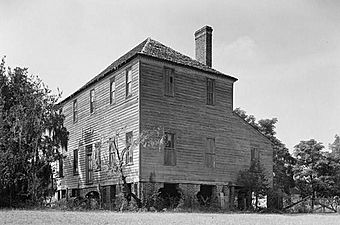Friendfield Plantation facts for kids
Quick facts for kids |
|
|
Friendfield Plantation
|
|

Silver Hill Plantation, Friendfield Estate
|
|
| Lua error in Module:Location_map at line 420: attempt to index field 'wikibase' (a nil value). | |
| Nearest city | Georgetown, South Carolina |
|---|---|
| Area | 3,305 acres (1,337 ha) |
| Built | 1830 |
| Architect | Walter Mellor and Arthur I. Meigs (Friendship House, 1931-36) |
| Architectural style | Colonial Revival (Friendship House) |
| MPS | Georgetown County Rice Culture MPS |
| NRHP reference No. | 96000409 |
| Added to NRHP | April 12, 1996 |
Friendfield Plantation is a large historic area of land, about 3,305 acres, near Georgetown, South Carolina. It's made up of parts of six older plantations and includes a building called Friendship House, built between 1931 and 1936. This important site was added to the National Register of Historic Places in 1996.
In the 1850s, about 230 African Americans were forced to work as slaves on Friendfield Plantation. They grew a huge amount of rice, around 900,000 pounds each year. One of these enslaved people was Jim Robinson, born in 1850. His descendant is former First Lady Michelle Obama.
Contents
What is Friendfield Plantation?
Friendfield Plantation is a big historical property. It includes many old buildings, structures, and sites. Today, the owners are Oscar Johnson Small II and his wife, Robbie Kephart.
Early Days and Rice Farming
The first owner of Friendfield Plantation was James Withers (1710-1756). He was a brick maker who became a planter, meaning he owned a large farm. Starting in 1734, he developed this plantation along the Sampit River. Here, they grew indigo and rice.
To work the fields, Withers bought enslaved people from Barbados. These individuals had been taken from Africa and brought to the Americas.
Life for Enslaved People
In the Low Country region of South Carolina, where Friendfield Plantation is located, enslaved African Americans developed a unique culture. This culture is known as the Gullah or GeeChee culture. It's special because it kept many traditions from Africa. This includes their language, food, and other customs.
Jim Robinson, an ancestor of Michelle Obama, was one of the Gullah people enslaved at Friendfield Plantation.
Changes After the Civil War
After James Withers, his grandson Francis Withers (1768-1847) owned the plantation. Francis built a new house on the property in 1818. Later, Francis's son-in-law, Dr. Alexius Mador Forster, III, managed the plantation.
However, after the American Civil War, the plantation faced hard times. Slavery ended, which changed how plantations operated. Also, prices for crops dropped. Many former slaves, now called freedmen, became sharecroppers. This meant they farmed the land and gave a part of their crop to the landowner. Jim Robinson, who became free at age 15, likely worked as a sharecropper here.
New Owners and New Uses
In 1897, the Withers family no longer owned Friendfield Plantation. Elizabeth Hunt Warham Forster sold it to B. Walker Cannon. Later, Patrick C. McClary, Sr. bought the property. He used it as a duck hunting club, which was a popular use for old plantations among wealthy owners in the early 1900s. In 1926, the original Friendfield House burned down.
In 1930, Radcliffe Cheston, Jr., a banker from Philadelphia, Pennsylvania, bought the plantation. He had a new Friendfield House built in 1932. This new house was designed by a famous architect named Arthur Ingersoll Meigs.
Leaving the South
Even into the 1950s, African-American sharecroppers lived and worked on the plantation. But during the early 20th century, many African Americans left the Southern states. This movement was called the Great Migration. They moved to industrial cities in the North, looking for better jobs and to escape unfair Jim Crow rules.
Michelle Obama's paternal grandfather, Fraser Robinson, Jr., moved to Chicago from the Georgetown area during this time. He and his wife, LaVaughn, later returned to the Low Country after they retired.
In 1989, Daniel Thorne partly bought the property. He co-owned it with Frances Cheston Train, Radcliffe Cheston's daughter. In 2015, Oscar Johnson Small II and Robbie Kephart bought the property.

